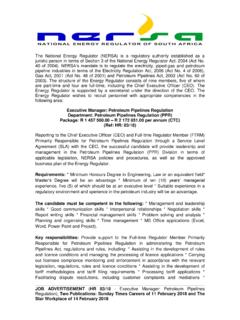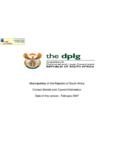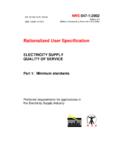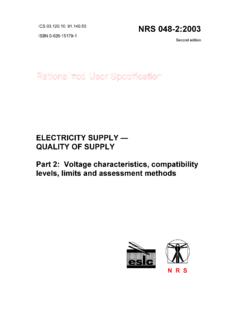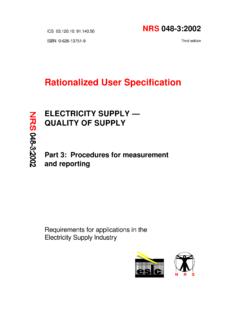Transcription of APPROVED MUNICIPAL ELECTRICITY TARIFFS
1 APPROVED MUNICIPALELECTRICITY TARIFFS2018/191 APPROVED MUNICIPAL ELECTRICITY TARIFFSF orewordI am pleased to present the 2018 /19 ELECTRICITY TARIFFS and prices publication of the National Energy Regulator of South Africa (NERSA).This is NERSA s eighth ELECTRICITY TARIFFS and prices publication. The aim of this publication is to provide ELECTRICITY users with information on all TARIFFS that have been APPROVED by the Energy Regulator. Our mandate of regulating prices and TARIFFS is derived from the ELECTRICITY Regulation Act, 2006 (Act No. 4 of 2006), which requires the Energy Regulator to regulate prices and TARIFFS in a way that enables an efficient licensee to recover the full cost of its licensed activities, including a reasonable return or margin.
2 The ELECTRICITY Regulation Act further states that a licensee may not charge a customer any other tariff and make use of provisions in agreements other than those determined or APPROVED by the Regulator as part of its licensing prices and TARIFFS publication is categorised into four distinct areas:I. the tariff objectives;II. basic tariff structures;III. basic customer categories; and IV. Inclining Block TARIFFS (IBTs).The publication contains prices and TARIFFS categorised into the nine different provinces per distributor, including the average percentage tariff increase as applied for by the respective distributors.
3 The TARIFFS are for implementation by licensees during the 2018 /19 financial trust that the publication will demonstrate NERSA s commitment to a fair and transparent process in striking a delicate balance between the interests of all the publication!_____Chris ForleeChief Executive Officer2 APPROVED MUNICIPAL ELECTRICITY TARIFFSA bbreviations and AcronymsA ampereAC alternating currentc centsc/kWh cents per kilowatt-hourEPP ELECTRICITY Pricing Policy (As APPROVED by the Department of Energy)FBE Free Basic ElectricityHz HertzIBT Inclining Block TariffkVA kilovolt-amperekvar/h reactive kilovolt-ampere-hourkV kilovoltkW kilowattkWh kilowatt-hourMFMA MUNICIPAL Finance Management Act, No.
4 56 of 2003N/A not applicableNERSA National Energy Regulator R RandR/Amp Rand per AmpereR/month Rand per monthR/kVA Rand per kilovolt-ampererms root mean squareTOU Time-of-UseV voltVAT value added taxW watt < less than less than or equal to> greater than greater than or equal toAbbreviations and AcronymsAbbreviations and Acronyms 02 Definitions 031.
5 Introduction 042. Tariff Objectives 043. Basic Tariff Structures 054. Basic Customer Categories 065. Provision of Free Basic ELECTRICITY (FBE) 066. Conclusion 06 Provincial APPROVED TariffsWestern Cape Province 07 Free State Province 50 Northern Cape Province 80 Eastern Cape Province 93 North West Province 110 KwaZulu-Natal Province 122 Gauteng Province 142 Limpopo Province 168 Mpumalanga Province 1793 APPROVED MUNICIPAL ELECTRICITY TARIFFSD efinitionsBasic charge covers the costs of the administration of the account. It is a contribution towards fixed costs such as meter reading, billing and administration.
6 It is a fixed charge payable every month for all metered connections whether ELECTRICITY is consumed or reflective TARIFFS are TARIFFS that distinguish between the unique cost components (or cost drivers) for a specific customer or customer class and where the cost components recover the full economic cost to supply ELECTRICITY to that customer. Distributor a licensee or his/her appointed representative who constructs, operates and maintains the distribution charge is a charge for each unit of energy consumed typically charged as c/kWh. For some TARIFFS the charge may be time and/or seasonally differentiated.
7 Free Basic ELECTRICITY (FBE) the State s Free Basic ELECTRICITY initiative, which allows for a limited amount of free ELECTRICITY as deemed necessary to provide basic services as determined and funded in terms of State policy in order to alleviate voltage nominal voltage levels equal to or greater than 44kV up to and including Block Tariff (IBT) is a tariff structure where the customers consumption is divided into blocks. Each block has a price per unit of energy consumed in that block; the tariff is low at the first block and increases with each succeeding block it consists of different prices for different energy consumption Voltage a nominal of 400V ( 10%) between any of the three-phase conductors and 230V ( 10%) between any phase and the neutral conductor.
8 Medium voltage nominal voltage levels greater than 11kV and up to and including charge is a charge payable per premise every month. The purpose of the network charge is to recover part of the fixed network costs (including capital, operations, maintenance and refurbishment) associated with the provision of network capacity required and reserved by the customer. For some TARIFFS the network charge is unbundled into a Network Demand Charge (NDC) and/or a Network Access Charge (NAC)- Network demand charge is a charge that recovers network costs on a variable basis and is payable for the chargeable demand registered during the month.
9 - Network access charge is a charge that recovers network costs on a fixed basis and is based on the annual utilised energy charge is a charge applicable if applied to Time-of-Use TARIFFS and is based on the reactive power used. It is levied on every kvar/h (reactive energy) which is registered in access of 30% of the kWh (active energy) supplied during the specified periods of the month. There is no reactive energy charge for a customer operating with a lagging power factor of 96% or better. The method of calculating this excess differs and is described with the respective phase supply a 50Hz AC supply at 230V rms phase-to-neutral.
10 The neutral carries the full load is a combination of monthly charges each at particular rates that are usually escalated annually and are applied to recover measured quantities such as consumption and capacity costs and unmeasured quantities such as service structure the combination of different charges and their relationship to each supply a 50Hz AC supply at 230V rms phase-to-neutral; 400V rms phase-to-phase (120 degrees vector phase displacement).Time-of-Use is a tariff that has different energy rates for different time periods and seasons in order to more accurately reflect the shape of the distributors long run marginal energy cost of supply at different surcharge is a percentage surcharge levied to customers with lower supply voltages as a contribution to the cost to transform ELECTRICITY from 11kV to lower voltages.
